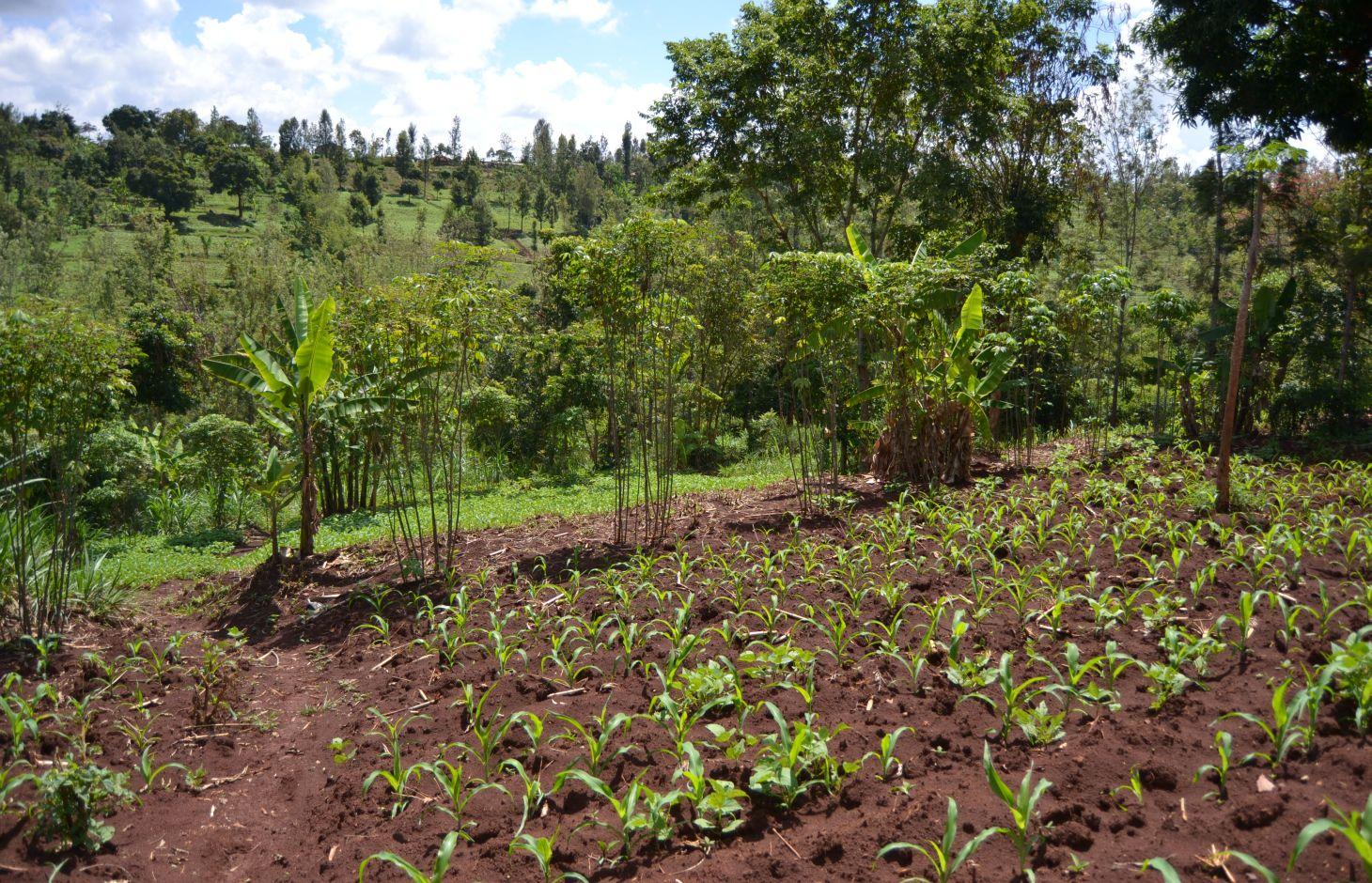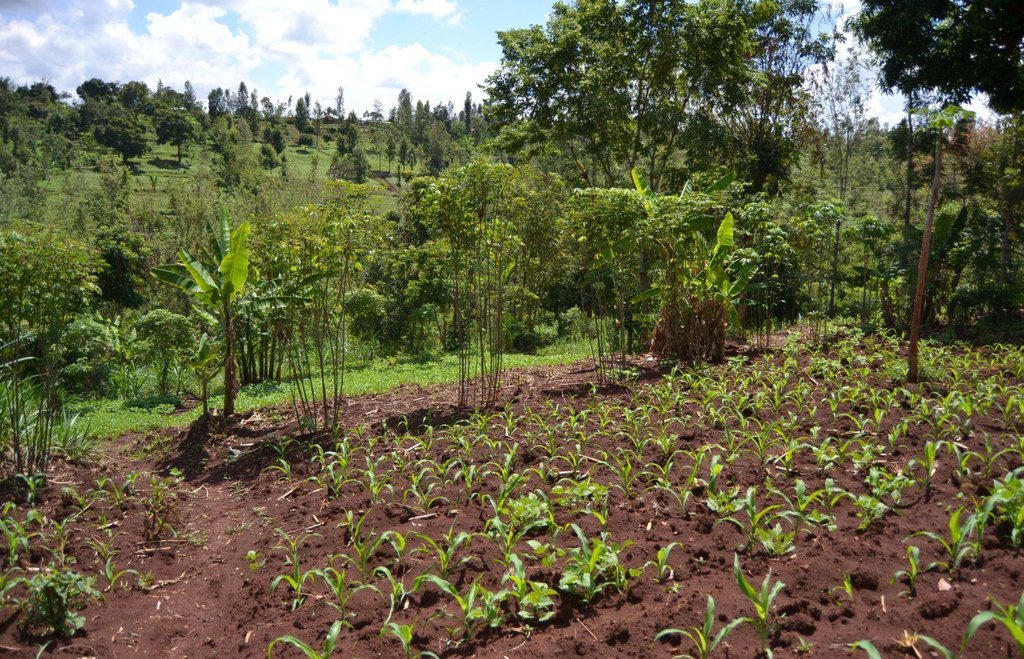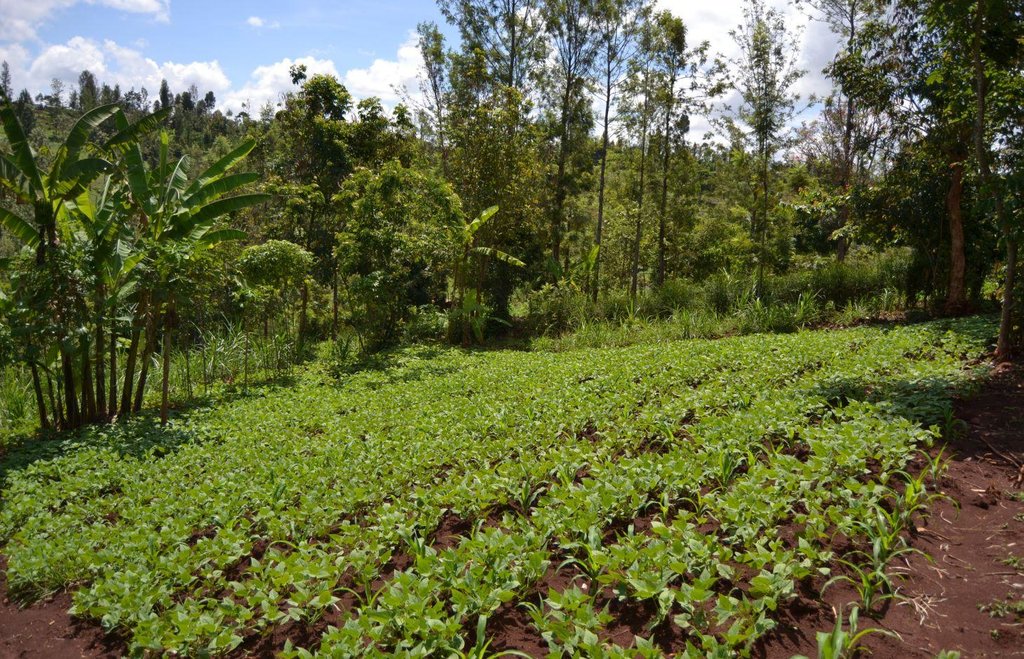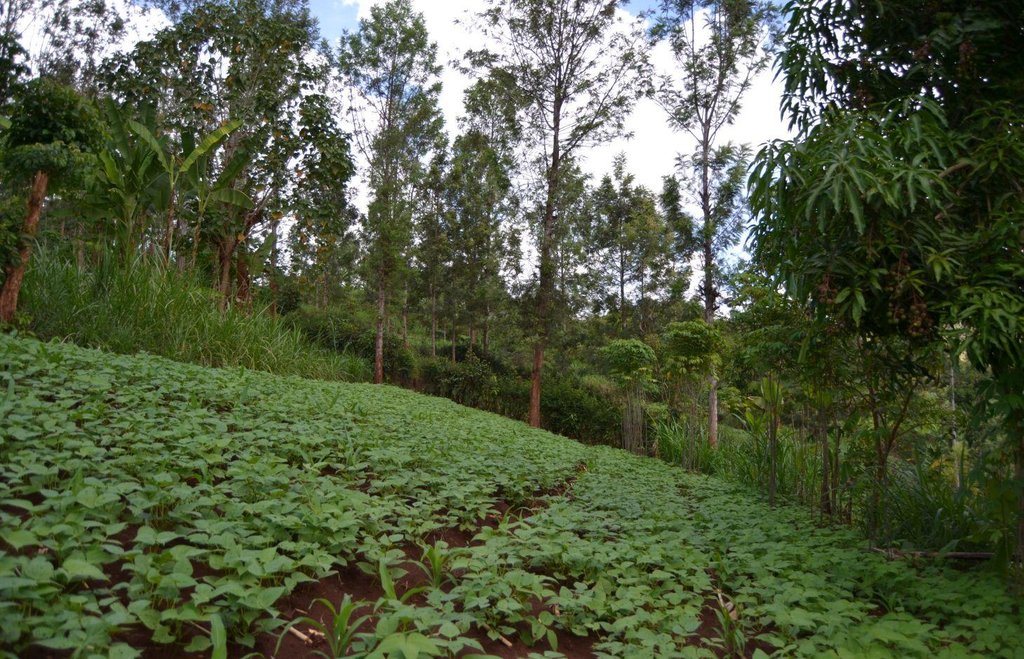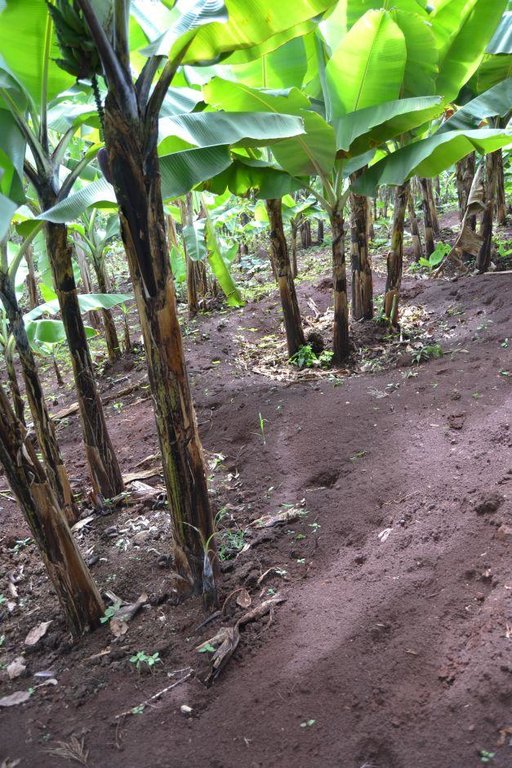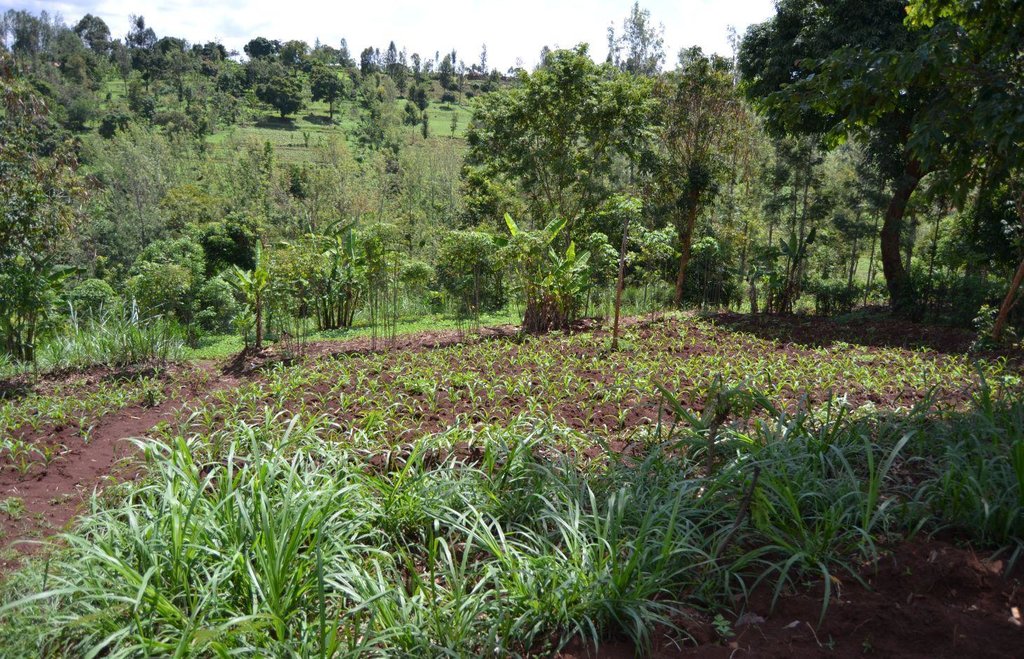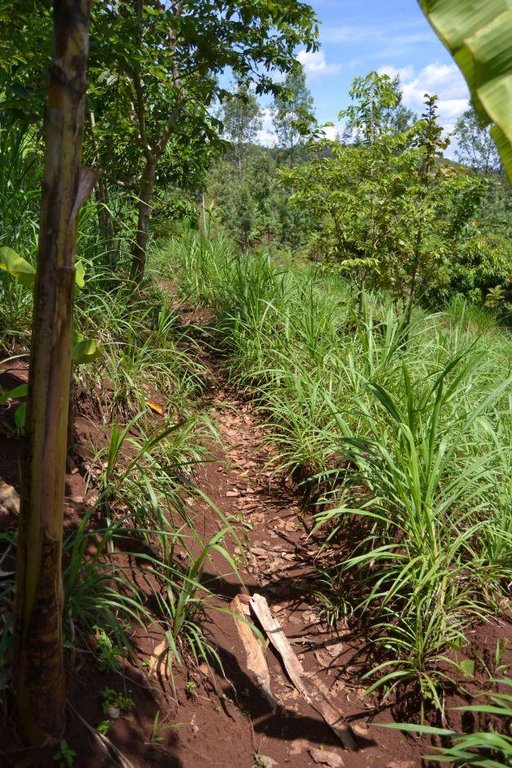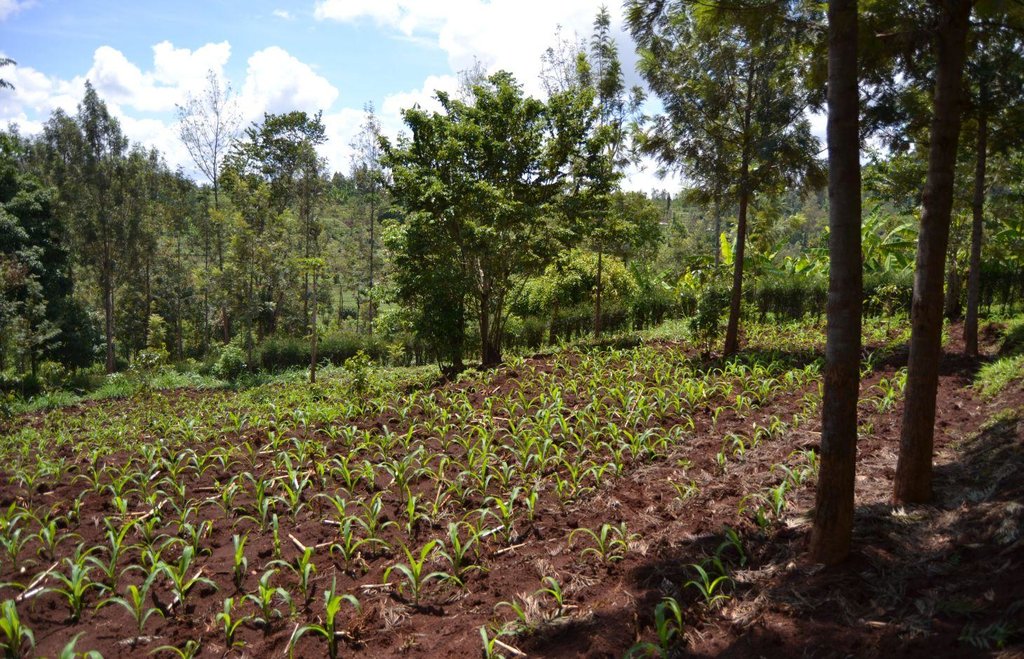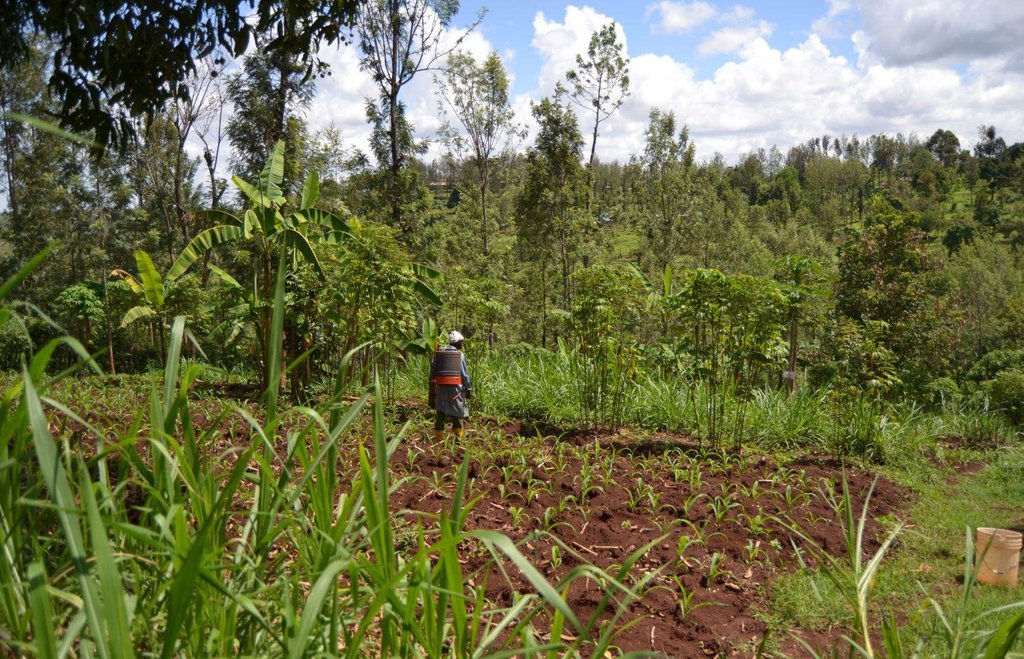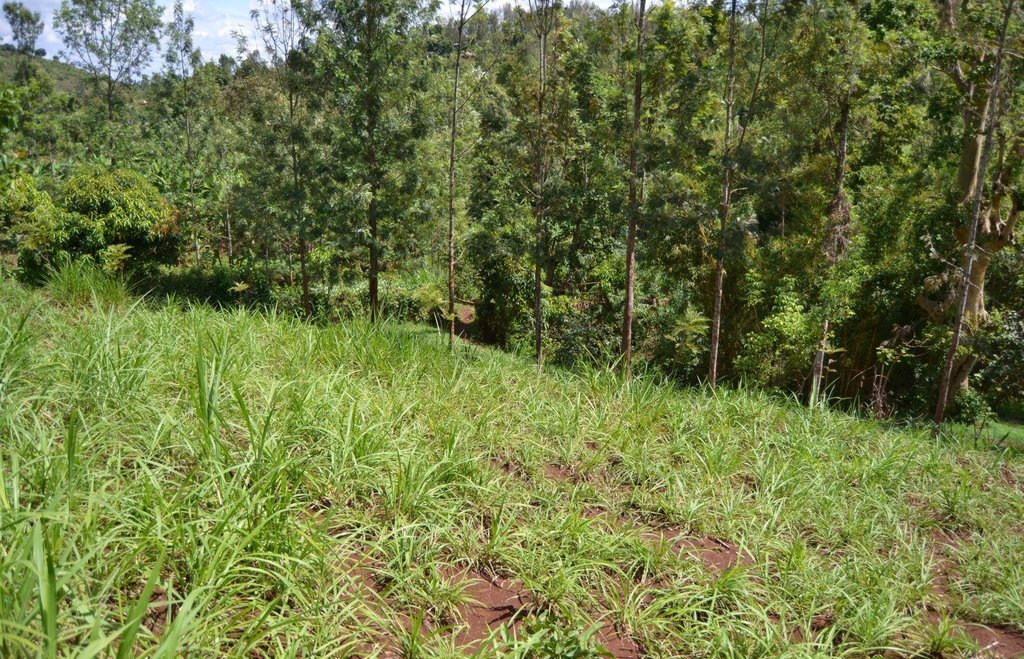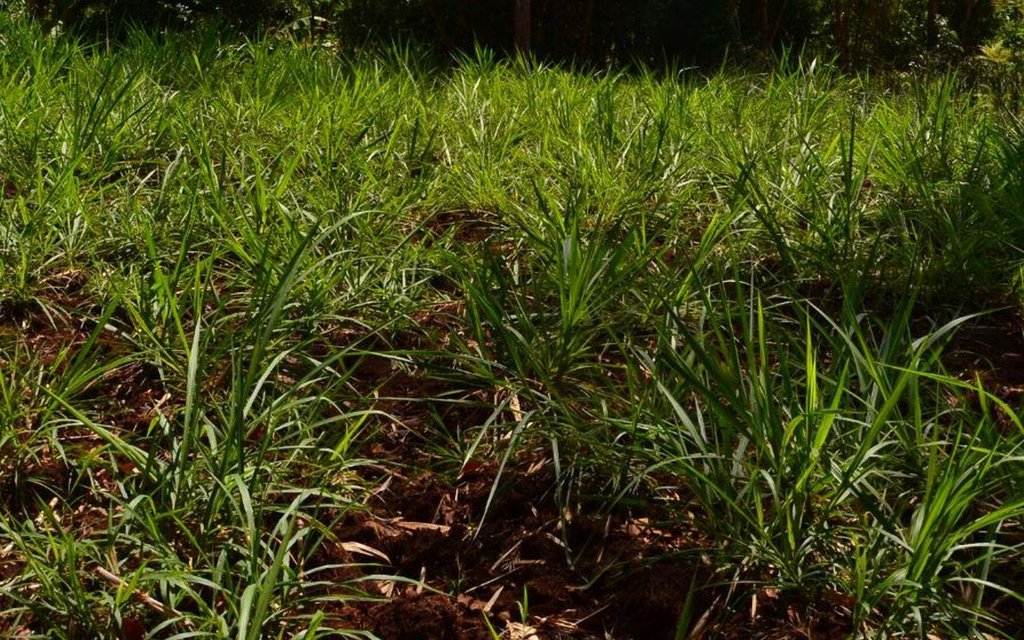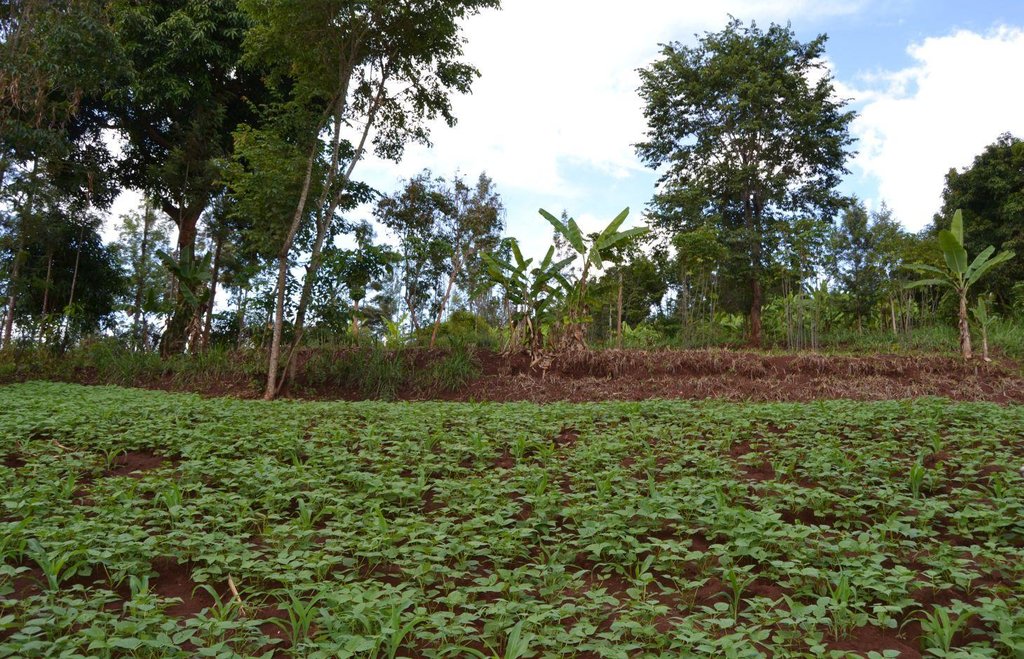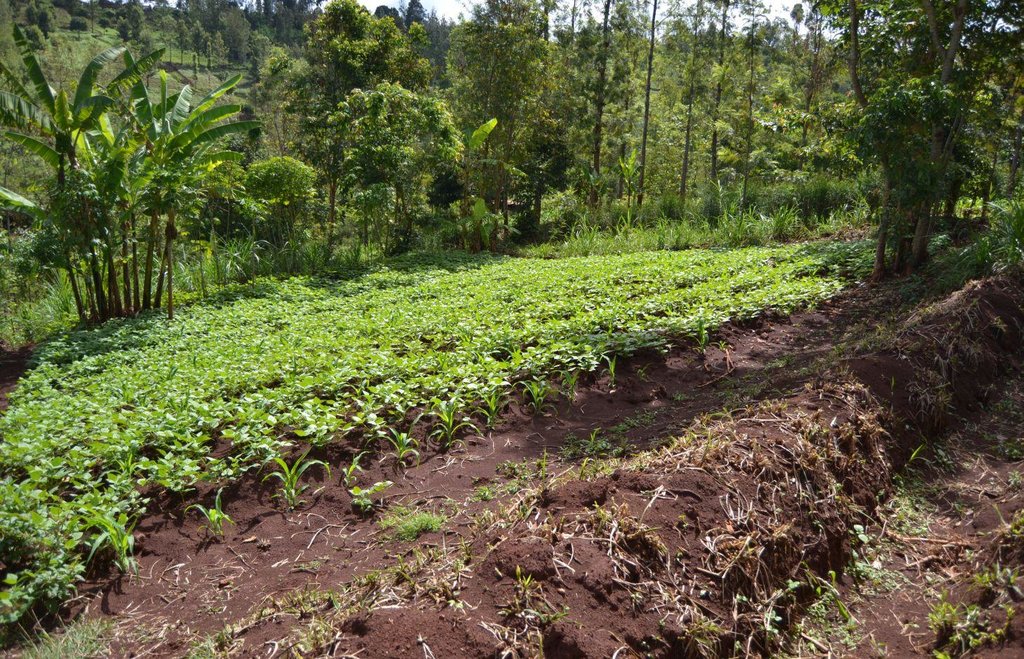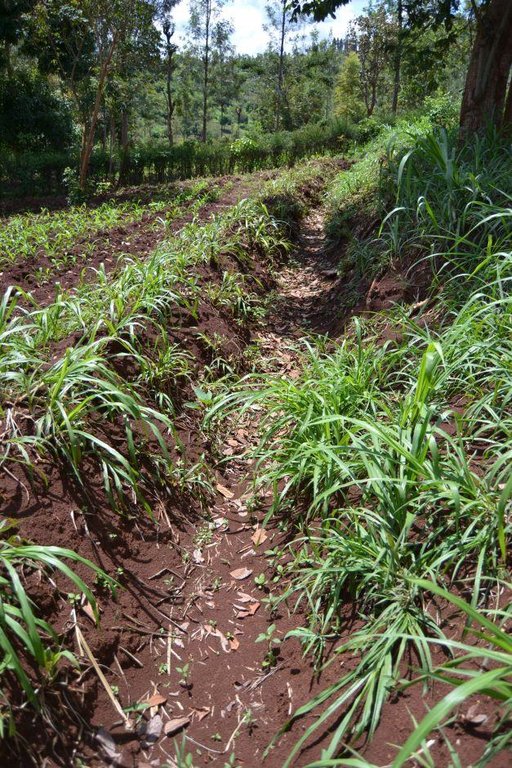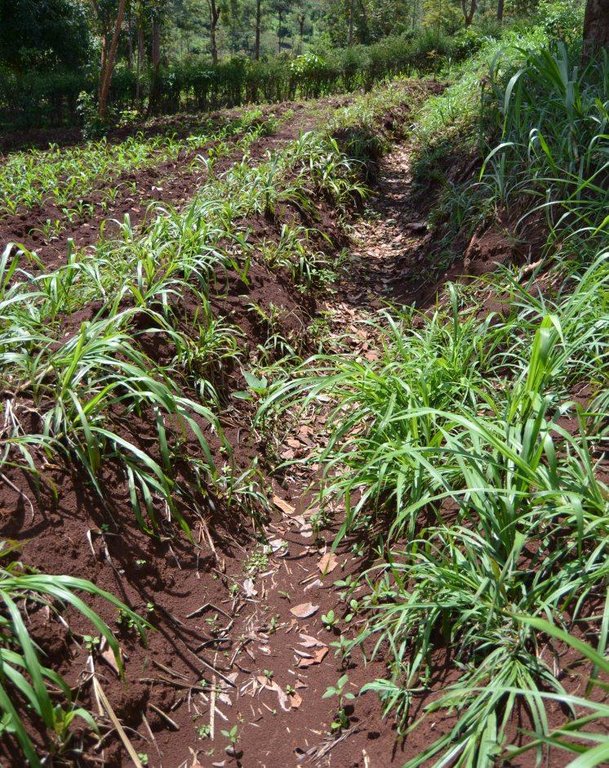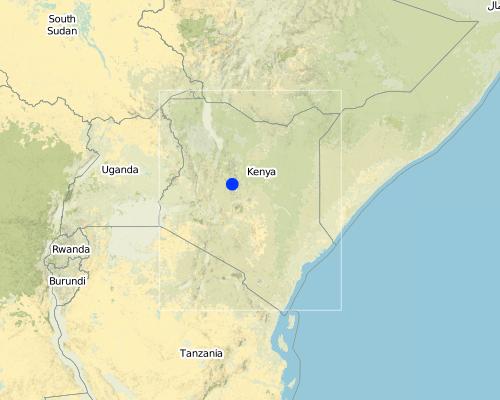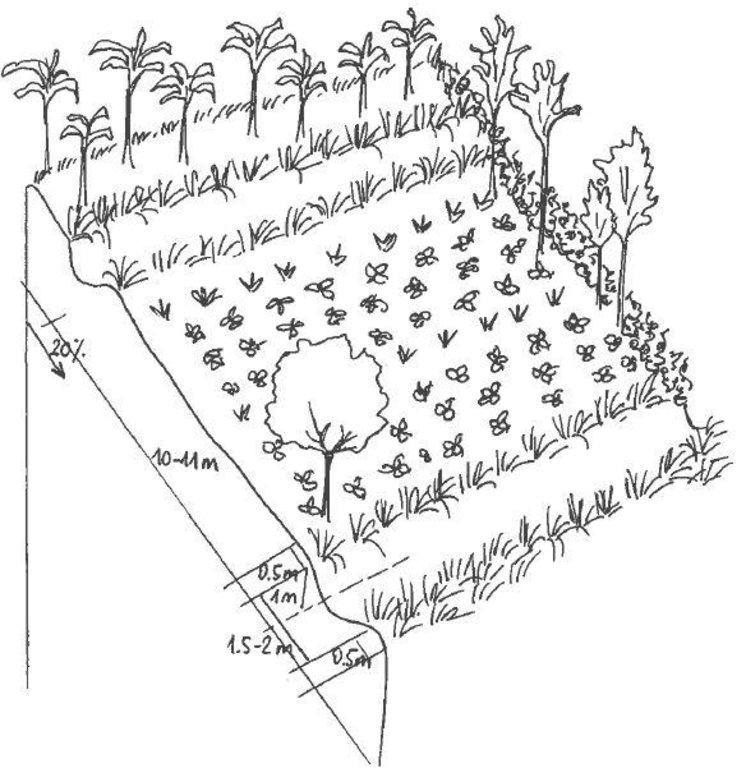Agroforestry system (intercropping beans/maize) with contour ditches, strips of Napier grass, manure and organic fertilizers. [Kenya]
- Création :
- Mise à jour :
- Compilateur : Laura D'Aietti
- Rédacteur : –
- Examinateur : Alexandra Gavilano
technologies_1146 - Kenya
- Résumé complet en PDF
- Résumé complet en PDF pour impression
- Résumé complet dans le navigateur
- Résumé complet (non formaté)
- Agroforestry system (intercropping beans/maize) with contour ditches, strips of Napier grass, manure and organic fertilizers.: 28 décembre 2016 (inactive)
- Agroforestry system (intercropping beans/maize) with contour ditches, strips of Napier grass, manure and organic fertilizers.: 5 juin 2017 (inactive)
- Agroforestry system (intercropping beans/maize) with contour ditches, strips of Napier grass, manure and organic fertilizers.: 7 mai 2019 (public)
Voir les sections
Développer tout Réduire tout1. Informations générales
1.2 Coordonnées des personnes-ressources et des institutions impliquées dans l'évaluation et la documentation de la Technologie
Personne(s)-ressource(s) clé(s)
Spécialiste GDT:
Nyamu Joseph
WRUA Sabasaba
Kenya
1.3 Conditions relatives à l'utilisation par WOCAT des données documentées
Quand les données ont-elles été compilées (sur le terrain)?
02/11/2012
Le compilateur et la(les) personne(s) ressource(s) acceptent les conditions relatives à l'utilisation par WOCAT des données documentées:
Oui
2. Description de la Technologie de GDT
2.1 Courte description de la Technologie
Définition de la Technologie:
The technology is a combination of agricultural (e.g. intercropping, manure/compost/mulching), vegetative (e.g. Napier grass strips, trees planting) and structural (e.g. ditches) measures which aim to maximise the overall land yield in a sustainable manner (e.g. reducing soil erosion and increasing soil quality).
2.2 Description détaillée de la Technologie
Description:
The Agroforestry system combines trees plantation (Bananas, Grevillea and Avocados) for fruits and timber collection with cereal crop, maize (Zea mays). Indeed, in order to increase yields, strip intercropping is practiced: cereal crop (maize) is grown in association with pulse (food legumes): beans. Instead of using expensive commercial fertilizers, beans could facilitate maize growth due to the possible transfer of N during growth or after incorporation of the legume biomass, during the growth period of the cereal (Sangakkara et al., 2003). Furthermore, soil quality (e.g. soil structure) is improved because of the increased amount of humus and organic matter and a better soil cover helps in preventing splash erosion and increase soil moisture content and therefore fertility. Indeed, beans have a beneficial impact for weed control (probably due to the shadow effects) and soil moisture content (Worfswinkel, undated; Odhiambo and Ariga, 2001). Planting different crops helps to diversify production and family food supply. Concerning SWC, hillside ditches have been created at the top of each 'terrace' and trees are also planted nearby and Cassava (a drought resistant plant) at the bottom. Manure/compost and organic fertilizers are supplied regularly both on maize/grass (twice a year) and Bananas (once), as good soil management practice. A higher level of organic matter in the soil indicates reduced bulk density, improved soil structure, aeration and higher water holding capacity (Olabode et al., 2007), which altogether improve the physical, chemical and biological properties of the soil (Haering and Evanylo, 2005). Bananas are planted in lines in the upper part of the land. The ditches, large 1m are excavated along the contour; they break slope into shorter segments 11 m long to intercept surface runoff. Ditches also help to prevent soil erosion and to avoid that nutrients and organic matter flow easily downwards into the river, instead they fall into the ditch. A live barrier of Napier grass is present above and below the edge of the five ditches, in two lines, to capture sediments and stabilize the structure, thus it is adequately protected. To conclude, a small area of the land is used to plant Napier grass only for fodder for grazing
Purpose of the Technology: Maize and beans are cultivated for home consumption while Avocados and Bananas are planted for economic (commercial) purposes. Fruits are sold out to the middle-men directly from the house (not at the market), to reduce costs (e.g. transport) and time. Avocados are sold at about 2.5/3 Ksh and Bananas at 200 Ksh. Grevillea trees are considered as saving, and sold out for timber production when the farmer is in need of cash, earning between 800 up to 1500 Ksh, depending on the size-lenght of the tree and the costs for cutting-transportation (e.g. machine operator). In general the selling of timber occurs per feet (running feet). ‘Whole” or standing tree is the preferred mode of selling trees from farms. Negotiation on sales is per tree ‘standing on farm’, with no processing or conversion. Buyers cut and cross cut, and carry timber from farms. Branches and slabs resulting from timber recoveries are left with the farmer depending on price negotiation; if the buyer carries these products then the price of the tree is adjusted upwards (Carsan and Holding , 2006; Holding et al., undated). Furthermore, the farmer underlined how 'bad prunings' at the top of the trees cause holes inside the trunks and thus a higher risk of fungi attacks and other diseases. The majority of the trees are planted along the boundaries of the land, for demarcation and only few are 'dispersed' on the cropland, to avoid excess of shadow to the cereal crop
Establishment / maintenance activities and inputs: High initial input to construct ditches and planting crop; manure also requires regular work: feeding cows and collect droppings and distribute them twice during the year, also over Napier grass. Dry planting is the preferred practice and the seeds are soaked the night before planting; this practice is advisable especially when the growing period is very short (Schmidt et al., 1983); organic fertilizers are applied over maize after 1 week and during the growing period (after about 18 days). Further maintenance is necessary after every rainy season to remove the sediments accumulated into the ditch and for pruning Grevillea, every three seasons. As mentioned above, pruning requires skills and knowledge to avoid plant diseases and labour is expensive because it is high risk work. The farmer trees plantation account for: 15 Avocados (from 4 seedlings), 100 Bananas (from cutting new suckers) and 50 Grevillea trees
Natural / human environment: The area is characterized by rolling-hilly slope and highly exposed to erosion and land degradation: planting trees protect the soil from nutrients leaching and create a litter which reduces evaporation during dry seasons. Concerning the variety of the trees, (e.g. Avocado) the farmer by grafting with better quality branches, improve the quality of the stock trees with certified variesties: out of 4 seedlings of Avocado (10 Ksh each), he has now 15 seedlings of the better (certified) variety called HASS, which performs well at 800-2100 m asl with well distributed annual rainfall of 1000-1200 mm (Youth Agro-environmental initiative website)
2.3 Photos de la Technologie
2.5 Pays/ région/ lieux où la Technologie a été appliquée et qui sont couverts par cette évaluation
Pays:
Kenya
Région/ Etat/ Province:
Central
Autres spécifications du lieu:
Muthithi location, Kagurumo sublocation
Map
×2.6 Date de mise en œuvre de la Technologie
Si l'année précise est inconnue, indiquez la date approximative: :
- il y a moins de 10 ans (récemment)
2.7 Introduction de la Technologie
Spécifiez comment la Technologie a été introduite: :
- grâce à l'innovation d'exploitants des terres
Commentaires (type de projet, etc.) :
Since the year 2000 the farmer adopted SWC practices in respond to the prolonged degraded situation of the land and its low yields.
3. Classification de la Technologie de GDT
3.2 Type(s) actuel(s) d'utilisation des terres, là où la Technologie est appliquée

Pâturages
Pâturage intensif/ production fourragère :
- Affouragement en vert/ zéro-pâturage
Principales espèces animales et principaux produits:
Cut-and-carry/ zero grazing: Fodder is provided to animals (2 cows) confined to a stall.

Mixte (cultures/ pâturages/ arbres), incluant l'agroforesterie
- Agroforesterie
Commentaires:
Major land use problems (compiler’s opinion): Sheet erosion with consequent nutrient leaching which could drain into the river.
Major land use problems (land users’ perception): Loss of soil fertility.
Grazingland comments: Fig. 10 Annex 3
Plantation forestry: Yes
Type of grazing system comments: Fig. 10 Annex 3
3.3 Informations complémentaires sur l'utilisation des terres
Approvisionnement en eau des terres sur lesquelles est appliquée la Technologie:
- pluvial
Nombre de période de croissance par an: :
- 2
Précisez:
Longest growing period in days: 122Longest growing period from month to month: from about March to JuneSecond longest growing period in days: 61Second longest growing period from month to month: from about October to November
Densité d'élevage/ chargement (si pertinent):
< 1 LU/km2
3.5 Diffusion de la Technologie
Commentaires:
Total area covered by the SLM Technology is 0.008 m2.
GATWAMIKWA village
3.6 Mesures de GDT constituant la Technologie

pratiques agronomiques
- A1: Couverture végétale/ du sol
- A2: Matière organique/ fertilité du sol
- A3: Traitement de la couche superficielle du sol

pratiques végétales
- V1: Couverture d’arbres et d’arbustes
- V2: Herbes et plantes herbacées pérennes

structures physiques
- S4: Fossés isohypses, trous
Commentaires:
Main measures: vegetative measures, structural measures
Secondary measures: agronomic measures
Type of agronomic measures: mulching, legume inter-planting, manure / compost / residues
Type of vegetative measures: aligned: -graded strips *<sup>3</sup>
3.7 Principaux types de dégradation des terres traités par la Technologie

érosion hydrique des sols
- Wt: perte de la couche superficielle des sols (couche arable)/ érosion de surface

dégradation chimique des sols
- Cn: baisse de la fertilité des sols et réduction du niveau de matière organique (non causée par l’érosion)

dégradation hydrique
- Hp: baisse de la qualité des eaux de surface
Commentaires:
Main causes of degradation: soil management (Poor soil management practices.), deforestation / removal of natural vegetation (incl. forest fires) (Poor vegetation cover, mainly herbaceous), disturbance of water cycle (infiltration / runoff) (Steep area (runoff)), Heavy / extreme rainfall (intensity/amounts) (Especially during wet seasons: March-June and October-November), education, access to knowledge and support services (Limited knowledge and training on SWC practices), governance / institutional (Limited or not adequate support)
Secondary causes of degradation: other natural causes (avalanches, volcanic eruptions, mud flows, highly susceptible natural resources, extreme topography, etc.) specify (From gentle to hilly slope), land tenure (Previous poor management SWC measures, especially in the upper areas)
3.8 Prévention, réduction de la dégradation ou réhabilitation des terres dégradées
Spécifiez l'objectif de la Technologie au regard de la dégradation des terres:
- prévenir la dégradation des terres
- réduire la dégradation des terres
4. Spécifications techniques, activités, intrants et coûts de mise en œuvre
4.1 Dessin technique de la Technologie
4.2 Spécification/ explications techniques du dessin technique
Agroforestry system, which covers an area of 2 acre. The plot is bordered by Euphorbia tirucalli (Kariaria, milk bush) and Grevillea trees. The ditches are characterized by barriers of Napier grass. Intercropping of maize and beans: the distance from one line of maize and the other is of 1m.
Technical knowledge required for land users: moderate
Main technical functions: control of dispersed runoff: retain / trap, control of dispersed runoff: impede / retard, reduction of slope angle, reduction of slope length, improvement of ground cover, increase of infiltration, increase / maintain water stored in soil, water harvesting / increase water supply, sediment retention / trapping, sediment harvesting
Secondary technical functions: improvement of topsoil structure (compaction), stabilisation of soil (eg by tree roots against land slides), increase in organic matter, increase in nutrient availability (supply, recycling,…), improvement of water quality, buffering / filtering water, increase of biomass (quantity)
Mulching
Material/ species: Organic residues around Banana trees
Quantity/ density: undefined
Legume inter-planting
Quantity/ density: 4 kg
Manure / compost / residues
Material/ species: Leftovers and manure from two cows
Quantity/ density: 8 tonnes
Remarks: (for 1 year). The mix of organic material is left decomposed in a big hole.
Agronomic measure: organic fertilizers
Material/ species: Acid humic and N, P, K, microelements (Biodeposit Elixir: small bags (sachets) of 12 ml)
Remarks: 5 bags (1×12 litre), applied only on maize
Aligned: -graded strips
Vegetative material: T : trees / shrubs, F : fruit trees / shrubs, G : grass
Number of plants per (ha): 100 a strip
Vertical interval between rows / strips / blocks (m): few cm
Spacing between rows / strips / blocks (m): 1
Vertical interval within rows / strips / blocks (m): 0.25
Width within rows / strips / blocks (m): 1
Trees/ shrubs species: Grevillea (Grevillea robusta)
Fruit trees / shrubs species: Avocados (Persea americana- Mũkorobia), Bananas (Musa sapientum- Irigũ)
Grass species: Pennisetum pyramidalis (Napier grass or elephant grass)
Slope (which determines the spacing indicated above): 10%
If the original slope has changed as a result of the Technology, the slope today is (see figure below): 15%
Gradient along the rows / strips: 5-8%
Diversion ditch/ drainage
Spacing between structures (m): 1
Depth of ditches/pits/dams (m): 40/50
Width of ditches/pits/dams (m): 0.6/1
Slope (which determines the spacing indicated above): 5-8%
Lateral gradient along the structure: 15-20%
4.3 Informations générales sur le calcul des intrants et des coûts
autre/ monnaie nationale (précisez):
Kenyan Schellings
Indiquer le taux de change du dollars en monnaie locale (si pertinent): 1 USD= :
85,9
Indiquez le coût salarial moyen de la main d'œuvre par jour:
2.00
4.4 Activités de mise en place/ d'établissement
| Activité | Type de mesures | Calendrier | |
|---|---|---|---|
| 1. | Digging holes (1 feet ×1 feet) and planting trees (e.g. Grevillea trees along the boundaries and in line below the bunds of the ditches) | Végétale | March (before rains), 1 year |
| 2. | Establishment of the ditches(digging ditch and creating soil bunds donward) and terracing. For 1 (in tot. are 5) : 2 p.d. * 1 day at 200 Ksh a day each. | Structurel | 2 times per year |
4.5 Coûts et intrants nécessaires à la mise en place
| Spécifiez les intrants | Unité | Quantité | Coûts par unité | Coût total par intrant | % des coût supporté par les exploitants des terres | |
|---|---|---|---|---|---|---|
| Main d'œuvre | labour | 1,0 | 7,0 | 7,0 | 100,0 | |
| Equipements | Machine to grill/mill maize leftovers (chap cutter) | 1,0 | 1164,0 | 1164,0 | 100,0 | |
| Equipements | Generator | 1,0 | 582,0 | 582,0 | 100,0 | |
| Autre | cows 2 | 1,0 | 349,0 | 349,0 | 100,0 | |
| Coût total de mise en place de la Technologie | 2102,0 | |||||
Commentaires:
Duration of establishment phase: 6 month(s)
4.6 Activités d'entretien/ récurrentes
| Activité | Type de mesures | Calendrier/ fréquence | |
|---|---|---|---|
| 1. | Prepare and apply fertilizers (organic) (See Annex 3, Fig. 9&comments) | Agronomique | Ferlizer application: after 1 week and 18 days, on maize only |
| 2. | Prepare manure+compost/mulch (Summary 2.1.2 QT4): Labour (to grill/mill leftovers - 300 Ksh for fuel- leftovers to prepare food for cows-3 person days) rest, the farmer by himself feed cows on daily basis (3 times in a day). Fuel: 1litre×1 day (×3 days) | Agronomique | compost/manure: 2 times/year in the field+grass; once on Bananas (where also added mulch) |
| 3. | Harvesting maize/beans (around Feb/March and Ag/Sept) | Agronomique | 2 times |
| 4. | Apply manure, mulch and compost (during March/April-long rains+Sept) just before the rains, when nutrients infiltrate into the soil with rainwater) (Summary 2.1.2 QT4) | Agronomique | Compost/manure: 2 times/year in the field+grass; once on Bananas (where also added mulch) |
| 5. | Tilling-soil (digging holes to plant maize/beans: 7 inches deep (17cm), spaced 1 feet (0.30 m) in contours: dry planting (before rains starts) | Agronomique | Twice a year, before rainy season (around March/Sept) |
| 6. | Digging planting holes and planting grass (2 persons × 3 days: 200 Ksh) | Végétale | Every season (March/April and Sept/Oct) |
| 7. | Maintenance (weed control and cutting Napier grass and collecting fodder) (Fig. 11 Annex 3) | Végétale | Every season (March/Sept); cutting Napier: 3/4 times in a season |
| 8. | Pruning branches and let them dry for firewood | Végétale | Every 3 seasons (and when shortage of firewood) |
| 9. | Clearing the tree for selling timber (the price depends also of the use of the chainsaw (or saw) or not | Végétale | When in need of cash (not regularly), not less than 5 years after planting |
| 10. | Repairing the ditches and remove excess of soil/leaves accumulated during the rainy season | Structurel | After rains (every season) |
4.7 Coûts et intrants nécessaires aux activités d'entretien/ récurrentes (par an)
| Spécifiez les intrants | Unité | Quantité | Coûts par unité | Coût total par intrant | % des coût supporté par les exploitants des terres | |
|---|---|---|---|---|---|---|
| Main d'œuvre | Labour | 1,0 | 183,0 | 183,0 | ||
| Equipements | fuel | 1,0 | 7,0 | 7,0 | ||
| Matériel végétal | seeds | 1,0 | 39,0 | 39,0 | 100,0 | |
| Matériel végétal | fertilizer | 1,0 | 23,0 | 23,0 | 100,0 | |
| Coût total d'entretien de la Technologie | 252,0 | |||||
Commentaires:
Machinery/ tools: the farmer prefers to use fork djembe then just the normal djembe (because it removes better the soil); panga and hoes., shovel, fork djembe, panga, saw, shovels, fork djembe
The costs has been computed during the period of the field visit and it include all the costs for the different structures: agronomic, vegetative and structural measures for 2 acre of land and summarized for 1 year period.
4.8 Facteurs les plus importants affectant les coûts
Décrivez les facteurs les plus importants affectant les coûts :
The main environmental constrain is water, in particular during dry season; An important cost is labour required to maintain all the SWC measures.
5. Environnement naturel et humain
5.1 Climat
Précipitations annuelles
- < 250 mm
- 251-500 mm
- 501-750 mm
- 751-1000 mm
- 1001-1500 mm
- 1501-2000 mm
- 2001-3000 mm
- 3001-4000 mm
- > 4000 mm
Zone agro-climatique
- subhumide
Thermal climate class: subtropics. June, July and August
5.2 Topographie
Pentes moyennes:
- plat (0-2 %)
- faible (3-5%)
- modéré (6-10%)
- onduleux (11-15%)
- vallonné (16-30%)
- raide (31-60%)
- très raide (>60%)
Reliefs:
- plateaux/ plaines
- crêtes
- flancs/ pentes de montagne
- flancs/ pentes de colline
- piémonts/ glacis (bas de pente)
- fonds de vallée/bas-fonds
Zones altitudinales:
- 0-100 m
- 101-500 m
- 501-1000 m
- 1001-1500 m
- 1501-2000 m
- 2001-2500 m
- 2501-3000 m
- 3001-4000 m
- > 4000 m
5.3 Sols
Profondeur moyenne du sol:
- très superficiel (0-20 cm)
- superficiel (21-50 cm)
- modérément profond (51-80 cm)
- profond (81-120 cm)
- très profond (>120 cm)
Texture du sol (de la couche arable):
- moyen (limoneux)
Matière organique de la couche arable:
- faible (<1%)
5.4 Disponibilité et qualité de l'eau
Profondeur estimée de l’eau dans le sol:
> 50 m
Disponibilité de l’eau de surface:
moyenne
Qualité de l’eau (non traitée):
eau potable
5.5 Biodiversité
Diversité des espèces:
- moyenne
5.6 Caractéristiques des exploitants des terres appliquant la Technologie
Revenus hors exploitation:
- > 50% de tous les revenus
Niveau relatif de richesse:
- riche
Individus ou groupes:
- individu/ ménage
Niveau de mécanisation:
- travail manuel
Indiquez toute autre caractéristique pertinente des exploitants des terres:
Population density: 10-50 persons/km2
Annual population growth: 2% - 3%
Off-farm income specification: The farmer is rich because he owns 3 acre of land and livestock, assets (electricity) which are above the average standards of the community. The farmer is retired from an accountancy service position several years ago.
Market orientation of production system: subsistence (self-supply), subsistence (self-supply), commercial/ market
5.7 Superficie moyenne des terres détenues ou louées par les exploitants appliquant la Technologie
- < 0,5 ha
- 0,5-1 ha
- 1-2 ha
- 2-5 ha
- 5-15 ha
- 15-50 ha
- 50-100 ha
- 100-500 ha
- 500-1 000 ha
- 1 000-10 000 ha
- > 10 000 ha
5.8 Propriété foncière, droits d’utilisation des terres et de l'eau
Propriété foncière:
- individu, avec titre de propriété
Droits d’utilisation des terres:
- individuel
Droits d’utilisation de l’eau:
- accès libre (non organisé)
Commentaires:
Water use rights depend on the use: open access for drinking and domestic uses.
5.9 Accès aux services et aux infrastructures
santé:
- pauvre
- modéré
- bonne
éducation:
- pauvre
- modéré
- bonne
assistance technique:
- pauvre
- modéré
- bonne
emploi (par ex. hors exploitation):
- pauvre
- modéré
- bonne
marchés:
- pauvre
- modéré
- bonne
énergie:
- pauvre
- modéré
- bonne
routes et transports:
- pauvre
- modéré
- bonne
eau potable et assainissement:
- pauvre
- modéré
- bonne
services financiers:
- pauvre
- modéré
- bonne
6. Impacts et conclusions
6.1 Impacts sur site que la Technologie a montrés
Impacts socio-économiques
Production
production agricole
production de bois
Revenus et coûts
dépenses pour les intrants agricoles
revenus agricoles
Impacts socioculturels
situation des groupes socialement et économiquement désavantagés
Impacts écologiques
Cycle de l'eau/ ruissellement
ruissellement de surface
évaporation
Sols
humidité du sol
couverture du sol
perte en sol
Biodiversité: végétale, animale
biomasse/ au dessus du sol C
6.2 Impacts hors site que la Technologie a montrés
disponibilité de l'eau
capacité tampon/de filtration
6.3 Exposition et sensibilité de la Technologie aux changements progressifs et aux évènements extrêmes/catastrophes liés au climat (telles que perçues par les exploitants des terres)
Changements climatiques progressifs
Changements climatiques progressifs
| Saison | Type de changements/ extrêmes climatiques | Comment la Technologie fait-elle face à cela? | |
|---|---|---|---|
| températures annuelles | augmente | pas connu |
Extrêmes climatiques (catastrophes)
Catastrophes météorologiques
| Comment la Technologie fait-elle face à cela? | |
|---|---|
| pluie torrentielle locale | bien |
| tempête de vent locale | bien |
Catastrophes climatiques
| Comment la Technologie fait-elle face à cela? | |
|---|---|
| sécheresse | pas bien |
Catastrophes hydrologiques
| Comment la Technologie fait-elle face à cela? | |
|---|---|
| inondation générale (rivière) | bien |
Autres conséquences liées au climat
Autres conséquences liées au climat
| Comment la Technologie fait-elle face à cela? | |
|---|---|
| réduction de la période de croissance | pas connu |
6.4 Analyse coûts-bénéfices
Quels sont les bénéfices comparativement aux coûts de mise en place (du point de vue des exploitants des terres)?
Rentabilité à court terme:
légèrement négative
Rentabilité à long terme:
légèrement positive
Quels sont les bénéfices comparativement aux coûts d'entretien récurrents (du point de vue des exploitants des terres)?
Rentabilité à court terme:
légèrement positive
Rentabilité à long terme:
positive
6.5 Adoption de la Technologie
Commentaires:
100% of land user families have adopted the Technology without any external material support
There is a moderate trend towards spontaneous adoption of the Technology
6.7 Points forts/ avantages/ possibilités de la Technologie
| Points forts/ avantages/ possibilités du point de vue de l'exploitant des terres |
|---|
| Better yields thanks to the intercropping measures taken. |
| Points forts/ avantages/ possibilités du point de vue du compilateur ou d'une autre personne ressource clé |
|---|
|
Intercropping is a commonly known practice which improves the overall conditions of the soil and provide better yields. How can they be sustained / enhanced? Besides 'companion planting' there are plants which can be grown as forerunner plants (Storey, 2002). Depending also on the type of soil, attention could be given to some sps. which accumulate concentration of e.g. mineral accumulators, phosporus, potassium, calcium, silica and sulphur . Another way to perhaps enhance the yields is relay intercropping. It is undersowing the next crop into the present crop, so that the present crop is a nurse crop and time and water is saved in the establishment of the following crop (Storey, 2002) Green manure as a way to add organic nutrients and combine more than one green manure and rotate, both legume (e.g. cowpeas, soybeans, annual sweet clover, vetch, sesbania, and velvet beans ) and not legume (e.g. sudangrass, millet, sorghum, and buckwheat). |
|
Agroforestry (Dispersed trees on cropland): The technology is simple to adopt and improves a sustainable land management as well as diversification of income sources and food supply. How can they be sustained / enhanced? It could be implemented by increasing the number of trees planted (e.g. along the boundaries) and with sps. characterised by deeper root systems, to avoid further water competition. More Avocadoe trees could increase the opportunities for the farmer to be part of a CBO (Community Based Organization) addressed to marketing of Avocadoes for oil production. This could help the farmer to earn more money and invest more in SWC implementation and new methods, in the long run. The option of alley cropping (hedgerow Intercropping) with leguminous plants e.g. Sesbanian sesban (Ramachandran Nair-ICRAF, 1993) could be considered as another option. |
|
Napier grass has very good properties in holding soil; also for ditch stabilization and fodder production How can they be sustained / enhanced? Other herbaceous vegetation could be also planted in the field: e.g. Tithonia diversifolia (Mexican sunflower), an excellent (high quality-N, P, K concentration) green manure /nutrient release and medicinal plant, or could be also used as a major component of compost manure. It is an annual weed that can be used for several purposes: fodders, poultry feed, fuel, compost, land demarcation, soil erosion, building materials, shelter for poultry. It is characterized by adaptability to different environment, rapid growth, fast rate of decomposition. Nevertheless, there is the need to ascertain the extent to which this weed sps. could be used for soil improvement and to determine the best mode of application of the weed sps., (Olabode et al., 2007, Olubukola et al., 2013) and the fact that is a invasive weed (with an aggressive growth) it requires a good knowledge in the land management and weed control. |
| The attention to certified varieties give also more value to the production itself and at market level: an increase of the bargaining power creates more opportunities for better income and chances to explore new and bigger markets, (e.g. Avocados for oil production ). |
6.8 Faiblesses/ inconvénients/ risques de la Technologie et moyens de les surmonter
| Faiblesses/ inconvénients/ risques du point de vue du compilateur ou d'une autre personne ressource clé | Comment peuvent-ils être surmontés? |
|---|---|
| The technologies in place require maintenance and monitoring, especially during rainy seasons | Eventually subsides or be part of a CBO's (Community Based Organizations) or SHG (Self Help Groups); Still the measures already in place could be improved: diversification of trees (e.g. indigenous) and trainings (e.g. pruning etc) could help the farmer in avoiding tree diseases and allocate more efficiently resources. |
| The amount of work required to carry out all the activities is too much. |
7. Références et liens
7.2 Références des publications disponibles
Titre, auteur, année, ISBN:
Holding C., Carsan S., Njuguna P., 2004. Smallholder Timber Marketing: A Kenyan Experience. FAO/ICRAF/GoK multi-stakeholder programme. International Workshop on small holder timber production.
Titre, auteur, année, ISBN:
Odhiambo G.D. and Ariga E. S., 2001. Effect of intercropping maize and beans on Striga incidence and grain yield. Seventh Eastern and Southern Africa Regional Maize Conference. 11th -15 th February, 2001. pp. 183-186.
Titre, auteur, année, ISBN:
Olabode O.S., Sola O., Akanbi W.B., Adesina G.O., Babajide P.A., 2007. Evaluation of Tithonia diversifolia (Hemsl.) A Gray for Soil Improvement. World Journal of Agricultural Sciences 3 (4): 503-507.
Disponible à partir d'où? Coût?
http://www.idosi.org/wjas/wjas3(4)/15.pdf
Titre, auteur, année, ISBN:
Olubukola S. A., Aderemi Ojo Ezekiel-Adewoyin O., Dorcas Tinuke D., Akintoye Henry, 2010. Comparing the use of Tithonia diversifolia and Compost as soil amendments for growth and yield of Celosia argentea. New York Science Journal 3 (6).
Disponible à partir d'où? Coût?
http://www.sciencepub.net/newyork/ny0306/20_2680_ny0306_133_138.pdf
Titre, auteur, année, ISBN:
Ramachandran Nair P. K., 1993. An Introduction to Agroforestry- ICRAF.
Disponible à partir d'où? Coût?
http://www.worldagroforestry.org/units/library/books/PDFs/32_An_introduction_to_agroforestry.pdf?n=161
Titre, auteur, année, ISBN:
Sanchez M. A., 2012. Food vs wood: dynamic choices for Kenyan smallholders. A plan B research paper. Master of Science. Michigan State University.
Disponible à partir d'où? Coût?
http://ageconsearch.umn.edu/bitstream/134024/2/PeraltaSanchezPlanB.pdf
Titre, auteur, année, ISBN:
Sangakkara U.R., Richner W., Schneider M. K., Stamp P., 2003. Impact of intercropping beans (Phaseolus vulgaris L.) and sunhemp (Crotalaria juncea L.) on growth yields and Nitrogen uptake of maize (Zea mays L.) grown in the humid tropics during the minor rainy season. Maydica 48: 233-238
Disponible à partir d'où? Coût?
http://www.maydica.org/articles/48_233.pdf
Titre, auteur, année, ISBN:
Schmidt H., Swoboda R., Ralph Jätzold R., 1983. Farm Management Handbook of Kenya. Natural Conditions and Farm Management Information. Vol. 2.Part B: Central Kenya
Disponible à partir d'où? Coût?
http://www2.gtz.de/dokumente/bib/07-1284.pdf
Titre, auteur, année, ISBN:
Smith D. M., Jackson N. A., Roberts J.M. and Ong C.K., 1999. Root distributions in a Grevillea robusta-maize agroforestry system in semi-arid Kenya. Plant and Soil 211: 191–205, 1999.
Titre, auteur, année, ISBN:
Storey P. J., 2002. The conservation and improvement of sloping land. Volume 1: Practical understanding. Chapter 5: Improving the soil management.
Titre, auteur, année, ISBN:
Worfswinkel van M., undated. Intercropping of Annual Foodcrops, Agrobrief (Agromisa), N.4
Disponible à partir d'où? Coût?
http://www.allindiary.org/pool/resources/intercropping.pdf
Titre, auteur, année, ISBN:
Carsan S., Holding C., 2006. Growing farm timber: practices, market and policies. The Meru timber marketing pilot programme case studies and reviews. World Agroforestry Centre.
Disponible à partir d'où? Coût?
http://www.worldagroforestry.org/downloads/publications/PDFs/b14639.pdf
Titre, auteur, année, ISBN:
Chia-Chun Wu, 1998. Effective conservation practices for the cultivation of slopelands, Extension Bulletin (ASPAC/FFTC), No. 449, 7 p.
Disponible à partir d'où? Coût?
http://www.fao.org/prods/gap/database/gap/files/1272_CONSERVATION_ON_SLOPES.PDF
Titre, auteur, année, ISBN:
Crozier C., 1986. Soil Conservation Techniques for Hillside Farms. A Guide for Peace Corps Volunteers. Appropriate Technologies for Development. Peace Corps Information Collection & Exchange Reprint Series No. R-62. Peace Corps Institution.
Disponible à partir d'où? Coût?
(The Humanity Development Library website: http://www.nzdl.org/gsdlmod?a=p&p=home&l=en&w=utf-8)
Titre, auteur, année, ISBN:
CSIRO (Baldock J.) Soil carbon: the basics. website (http://www.csiro.au/en/Outcomes/Environment/Australian-Landscapes/soil-carbon.aspx) . Also in: Carbon Farming Fact Sheet: Store carbon for healthy soils and better yields.
Disponible à partir d'où? Coût?
http://www.grdc.com.au/uploads/documents/GRDC_CarbonFarming_4pp.pdf
Titre, auteur, année, ISBN:
Elemans A., 2011. Thesis report (unpublished): Green water credits program in Saba Saba sub-catchment in the Upper Tana, Kenya.
Titre, auteur, année, ISBN:
Gutteridge R. C. and Sheltong H. M., 1998.eridge R. C. and Shelton H. M., 1998. Forage tree legumes in tropical agriculture. (http://www.fao.org/ag/AGP/AGPC/doc/PUBLICAT/Gutt-shel/x5556e00.htm Chapter 5.2
Disponible à partir d'où? Coût?
http://www.fao.org/ag/AGP/AGPC/doc/Publicat/Gutt-shel/x5556e0q.htm
Titre, auteur, année, ISBN:
HDRA , undated. Agroforestry in the Tropics.
Disponible à partir d'où? Coût?
http://www.thenrgroup.net/member/MRO/AER/AER-560.htm
Titre, auteur, année, ISBN:
Haering, K., Evanylo G., 2005. Composting and Compost Use for Water Quality. In Composting resource directory. Mid-Atlantic Reg. Water Program.
Disponible à partir d'où? Coût?
http://infohouse.p2ric.org/ref/41/40137.pdf
Titre, auteur, année, ISBN:
Holding C., Carsan S., Njuguna P., undated. Smallholder timber and firewood marketing in the coffee and cotton/tobacco zones of eastern Mount Kenya. In: Small-scale forestry and rural development: The intersection of ecosystems, economics and society.
Disponible à partir d'où? Coût?
http://www.coford.ie/media/coford/content/publications/projectreports/small-scaleforestryconference/Holding.pdf
Liens et modules
Développer tout Réduire toutLiens
Aucun lien
Modules
Aucun module trouvé


